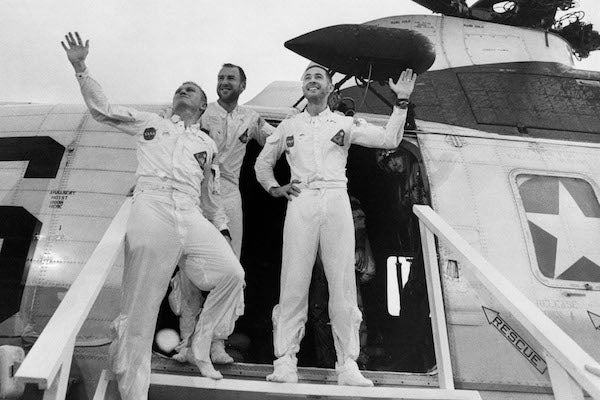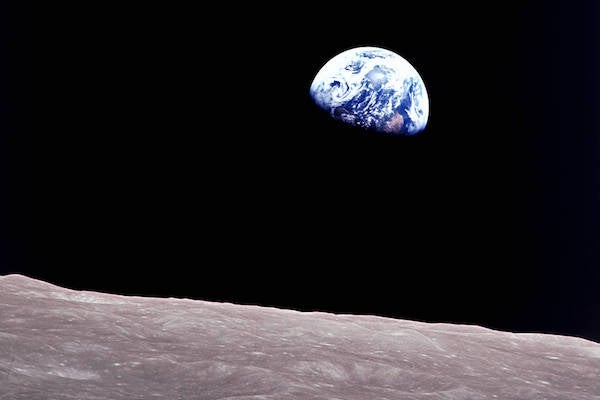A Half Century Later, the Journey of Apollo 8 Still Inspires

4 minutes read...
Written by Vitligo on 10 April 2023
On December 21, 1968, Apollo 8 was launched on one of the greatest journeys in the history of human exploration.
Imagine if Columbus took only the Santa María, sans landing boats, 3,000 miles across the Atlantic to the island of Hispaniola. Unable to go ashore, he circled it and recorded his observations in logbooks. Returning later with a three-ship flotilla to plant the flag would still be dramatic, but also a tad anticlimactic.
It’s hard to believe Apollo 8’s voyage around the moon had originally been scheduled as a less audacious Earth-orbit mission to test the whole moonship “flotilla”: the monstrous, still problem-prone Saturn 5 booster, along with the recently redesigned, and only once-flown-by-astronauts Apollo command ship, which was fashioned to carry a three-person crew to and from Earth and into moon orbit. For a landing, it was to fly in tandem with a lunar lander that would ferry two astronauts to and from the moon’s surface.
In 1968 the command ship was ready but the lander was behind schedule. Officials feared that if NASA were to wait for it to test the whole system in Earth orbit before heading moonward, then the goal set by Pres. John Kennedy of a landing there by the end of 1969 would be near impossible. Not only was the clock ticking, but also the CIA had informed the agency that it believed the Soviet Union was on the verge of launching cosmonauts on a moon mission.
In August 1968 NASA's Apollo Spacecraft Program Office manager, George Low, proposed making Apollo 8 a mission to circumnavigate the moon some 234,000 miles away. Working out the details in secret, the Apollo team realized they could do it and, while there, go into orbit.
Orbiting made the stakes even higher: If a failure of the spacecraft's rocket engine left astronauts Frank Borman, Jim Lovell and Bill Anders stranded, NASA Administrator Jim Webb feared we would have “ruined the moon” for poets, lovers and everyone who would look at the orb and know there were three dead astronauts circling there. And, if the new navigational, communication or reentry components had failed, the crew could have been lost in space or have burned up in Earth's atmosphere on returning home.
 Apollo 8 astronauts (left to right): Frank Borman, James A. Lovell Jr. and William A. Anders arrive on the carrier U.S.S. Yorktown after splashing down to complete the mission. Credit: NASA
Apollo 8 astronauts (left to right): Frank Borman, James A. Lovell Jr. and William A. Anders arrive on the carrier U.S.S. Yorktown after splashing down to complete the mission. Credit: NASA
That year, public enthusiasm for human spaceflight was as high as it ever would be but a failure might have dampened enthusiasm, thereby slowing or even stopping the U.S. from fulfilling its attempt to fulfill Kennedy's goal.
Apollo 8 realized many firsts, including the first time humans had set their eyes on the moon's farside as well as the fastest astronauts (or, for that matter, anybody) had ever traveled—around 25,000 miles per hour—through space and into Earth's atmosphere during reentry.
But what stands out for many is that it was also the first time most people back on Earth had seen their world as a sphere floating in the pitch-black void of space. The iconic Apollo 8 “Earthrise” photo taken over the lunar horizon is credited with inspiring global environmental consciousness and the cultural viewpoint of our world as a unique and extremely fragile planet that must be preserved.
What started as a gamble became one of humanity's greatest moments in exploration—and a public relations coup for NASA. Not only that, but people needed a moment like this in a year like 1968—one shattered by antiwar and race protests and riots; the assassinations of Martin Luther King, Jr., and Robert F. Kennedy; as well as war, both hot and cold.
 Earth, photographed by William A. Anders as Apollo 8 orbited the moon. Credit: NASA
Earth, photographed by William A. Anders as Apollo 8 orbited the moon. Credit: NASA
So, there it was, just what the doctor ordered: On Christmas Eve, pajama-clad kids who otherwise would be looking skyward for eight tiny reindeer were glued to their TV sets, along with an estimated half a billion people around the world, gaping at the moon’s stark, cratered surface hurtling by just 69 miles below and listening to awe-inspired astronauts who read “Genesis” and sent yuletide greetings to “all of you on the good Earth”—the same good Earth they had been viewing in black and white as a fuzzy, cloud-veiled, gibbous globe, like they had never seen it before. Small wonder then that when Borman got back, someone had sent him a message: “Thanks for saving 1968.”